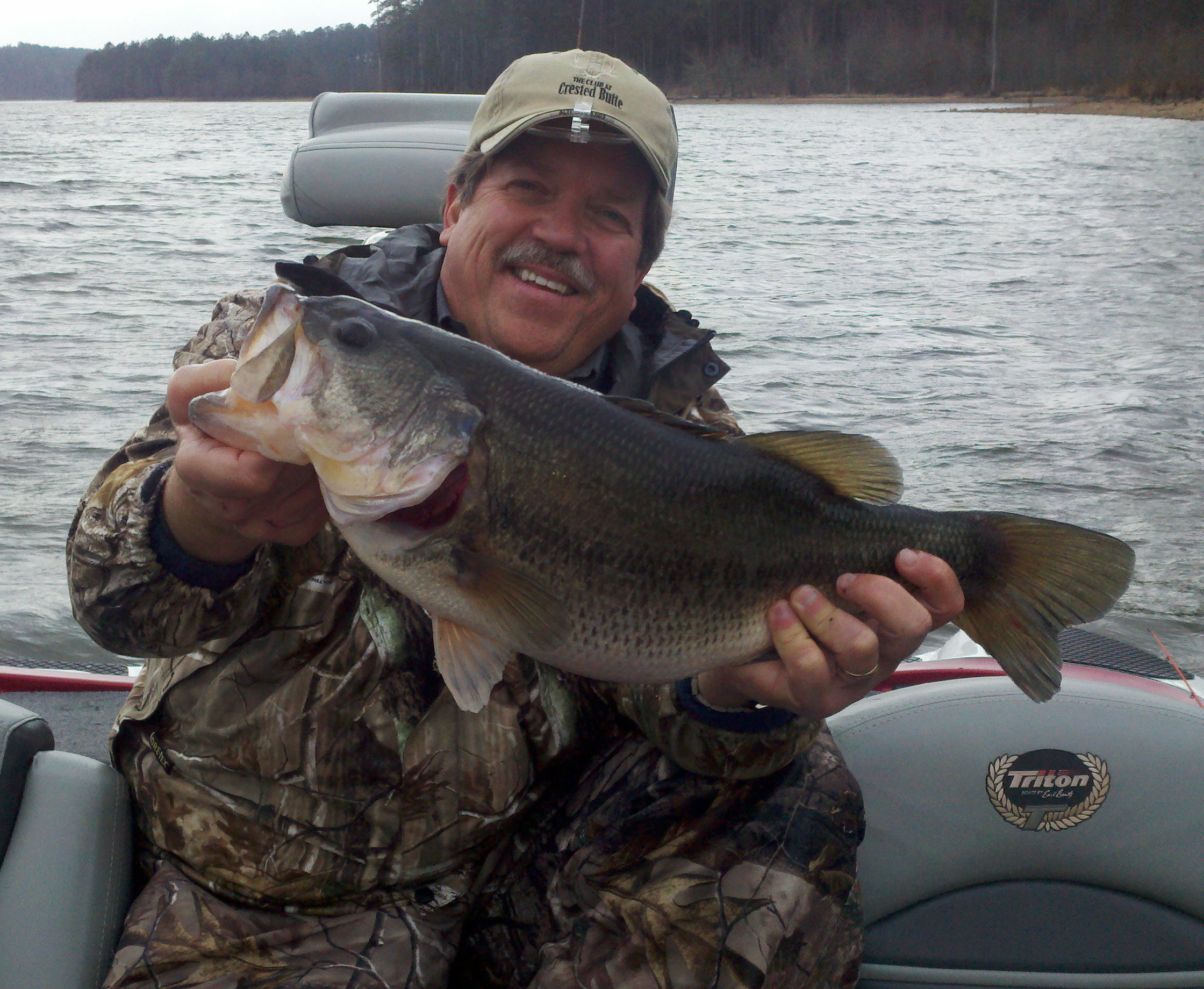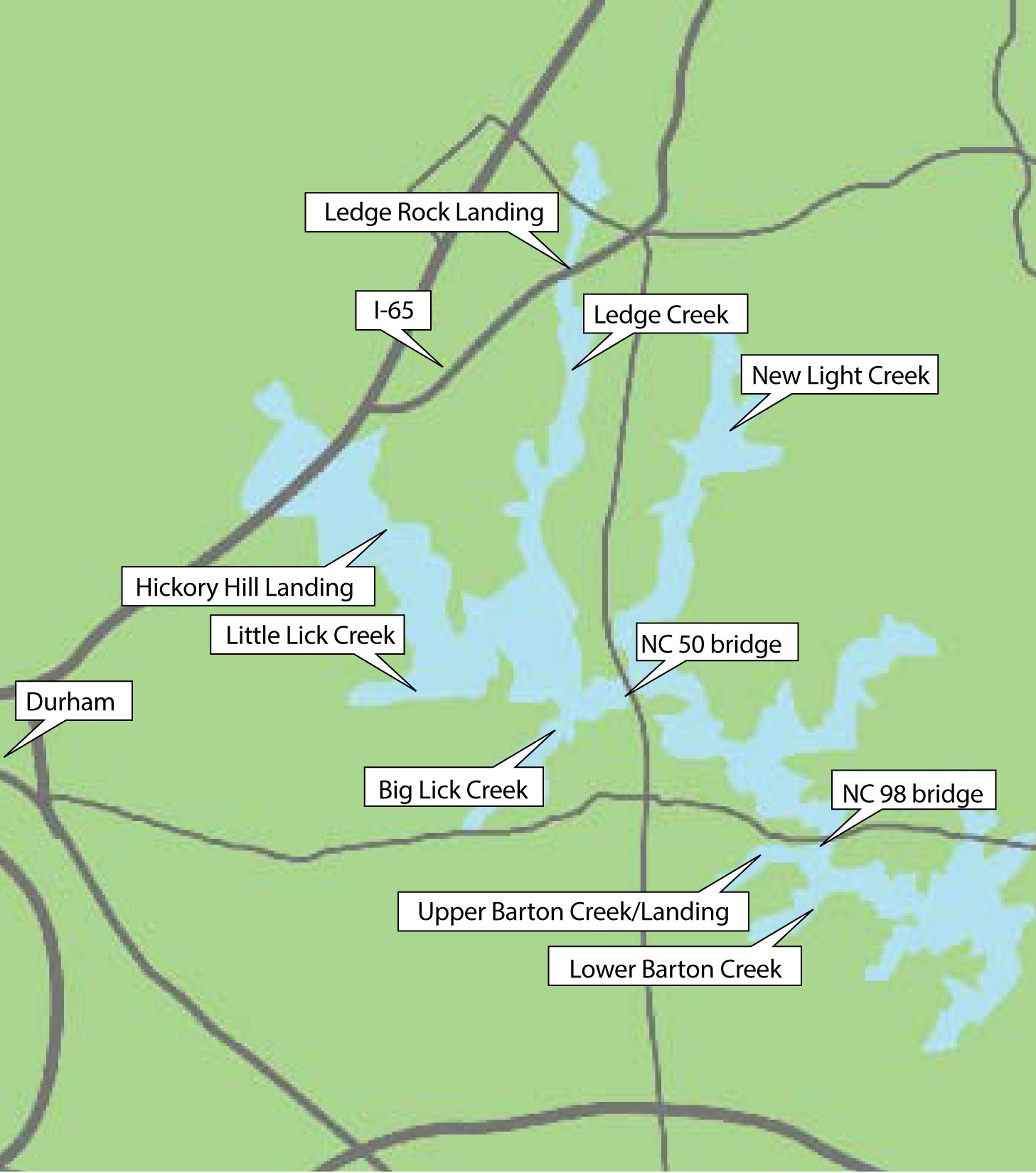
Look for water temperatures in the mid-50s and get out your bass tackle at Falls of the Neuse Lake.
Fishing during the prespawn can be some of the most-rewarding experiences for a bass angler. Fish that have been under the influence of winter weather are beginning to stretch their gills and begin to engage in the natural process of spawning.
A great trip to make is to Falls of the Neuse Lake, a 12,410-acre reservoir that rises north of Durham and flows east to the dam north of Raleigh. It has long been a body of water where bass begin to stir in late February and are full on filling their bellies in early March, as evidenced by several decades of huge catches.
“I call it March Madness for bass anglers,” said Rich Szczerbala, a former fishing guide and current tournament trail gypsy.
“If you don’t overthink the fishing, the prespawn is literally the best time of the year to fish,” said guide Joel Munday of Outdoor Expectations USA.
Both anglers represent honed experience and techniques in chasing bass just before the spawn, and while they may differ in how they approach it, both are successful on the reservoir that supplies water to some of the state’s biggest reservoirs.
Munday, for one, believes that ideal water conditions dictate how bass begin to spawn.
“I’m looking for water that is trending in the 45- to 50-degree range, with the upper being better,” says Munday.
For Szczerbala, water temperature between 55 to 58 degrees represents ideal conditions.
“The time of the year really dictates, as does the weather, which is why I focus on those areas that get the most benefit from the weather conditions, especially if it is warmth,” Szczerbala said. “This time of year, the bass are transitioning, and the need to warm is among the priorities they seek.”
Munday believes weather is the most-critical factor.
“Everything begins in February, but I have seen some days in late January, too; however, it all leads up to March,” he said. “Those warm days in March are the days to be on the water.”
Szczerbala believes the key to locating early contestants for the spawn is to find the areas around the mouth of feeder creeks that can be influenced by the wind.
“I study the prevailing winds for that day and the days before I fish. Essentially, I am seeking winds that are of a south and southwest flavor that will have warmed a particular area, giving fish the energy to chase bait and prepare for spawn,” Szczerbala said.
Munday focuses his pursuits on length of day and capitalizing on those non-traditional fishing times.
“The mid-day and late morning times are phenomenal for catching bass,” he said. “You just have to have the patience to stay with it.”
For Munday, a key in the search for prespawn bass is to understand why these fish are moving and concentrating a certain area.
“I believe that the fish venture to the shallows around a creek or structure and they hang here in search of bait or to get sun,” he said. “Yet, they are quite elusive here, too, because in these shallows they are easy prey for birds, so it is about finding the fish between where they hunt and warm and to where they want to be in a particular water-column.”
Szczerbala finds that the fish move from wintering locations to the in-between areas where they spawn.
“They move in phases, and I think the first move is the gradual shift towards structure,” he said. “I look for those areas where the wind is pushing towards the banks and there is an outcropping of rocks nearby or some other structure that hold bait.”

From his experience, Szczerbala believes that fishermen are sometimes fooled by where they think fish should be and where they really are.
“During the early phases, the fish are exploring, and there may be a situation where the fish are not there in the morning, but they return in the afternoon. You really just have to watch the wind and keep places where there is structure and warmth, in mind,” he said. “It is never advisable to pull up so close to the shore; instead, always hang back and fish from structure to the bank, working the water with smaller crankbaits, watching your electronics and noting the water temperature.
“Even though I am comfortable fishing a range of temperature, if I locate a prevailing wind that is pushing over shallow water and there is structure nearby — and the water temperature is between 55 and 58 degrees — then I classify that as one of those special days,” said Szczerbala, who remembers a late March tournament a few years ago. Fish were absent from the shallows in the morning, but he knew conditions would materialize over the course of the day.
“It was nearly perfect, the moon was full about three days before, the wind was calm and there had been no bites that morning. I knew that around noon the fish would perk-up and I just had to wait my time,” he said. “Sure enough, one by one, around lunch, I began to pick up fish, and when it was over I weighed 39.34 pounds.”
As a guide, Munday lets the conditions tell you what the fish are doing.
“Usually in the first few casts, I can figure out what is working and what will not work,” he said. “On Falls, for instance, I concentrate on the prespawn bass by seeking the creek channels that filter into the lake. It is all about looking at the water column and getting a feel for how the bass are holding. They are transitional fish this time of year, and ultimately, the goal is for them to spawn. The time leading up to that is when fishing is most bountiful.”
Szczerbala and Munday agree that being able to follow bass on their transition from winter to spring is a big advantage for a fisherman.
“The magic formula, or ideal formula, appears to be a connection between the wind blowing warmer air, shallow water where structure exists nearby, and … searching for those temperatures in the upper 50s,” Szczerbala said.
“When I am approaching the prespawn, I focus on small amounts of water, and I use small crankbaits. This allows me to quickly hone in on what the bass are interested in,” Munday said. “It is literally the best time for anglers to catch the biggest fish of the year, when they are going into the prespawn.”
“If you are able to time the full moon in March, happen upon a body of water that holds temperatures in the upper 50s, have a light wind and can identify structure on your electronics, all of these factors can contribute to an anglers dreams for catching prespawn bass,” Szczerbala said. “In my experience, the biggest fish spawn first, and that should be the motivating factor to getting anglers on the water in search of these fish. When it is over and the fish have spawned and are on the beds, it is virtually impossible to entice them to a bite.”
For local anglers venturing out in March, Szczerbala and Munday agree that the weather conditions and water temperatures conditions should be the two most-important factors in considering when and where to fish.
“They want to hide and warm and hunt and do what they do as prespawn fish; you just have to be patient and search for where they are during this transition,” Szczerbala said.
DESTINATION INFORMATION
 WHEN TO GO/HOW TO GET THERE — Traditionally, bass action starts to crank up the last week of February and first week of march at Falls of the Neuse, and good prespawn fishing will continue through March and into April. NC 98 and NC 50 are two highways that lead most fishermen to public ramps on the lake; they intersect a few miles south of the mid-lake area. The lake’s headwaters are west of I-85, north of Durham. The dam is north of Raleigh, about 17 miles downstream from I-85. Popular ramps are Ledge Rock, Upper Barton Creek, Hickory Hill, and in the Highway 50, B.W. Wells and Holly Point campgrounds.
WHEN TO GO/HOW TO GET THERE — Traditionally, bass action starts to crank up the last week of February and first week of march at Falls of the Neuse, and good prespawn fishing will continue through March and into April. NC 98 and NC 50 are two highways that lead most fishermen to public ramps on the lake; they intersect a few miles south of the mid-lake area. The lake’s headwaters are west of I-85, north of Durham. The dam is north of Raleigh, about 17 miles downstream from I-85. Popular ramps are Ledge Rock, Upper Barton Creek, Hickory Hill, and in the Highway 50, B.W. Wells and Holly Point campgrounds.
TECHNIQUES/TACKLE — Start in mid-lake areas on the main lake and work your way back into creeks as the month progresses. Pay careful attention to wind direction and where it might push warmer water into the shallows. Top lures for March include shallow-running crankbaits like Shad Raps, lipless crankbaits, spinnerbaits and Alabama Rigs. Medium-action baitcasting tackle will take care of most situations.
GUIDES/FISHING INFO — Joel Munday, Outdoor Expeditions USA, 919-669-2959, www.outdoorexpeditionsusa.com; Bayleaf USA Bait & Tackle, Raleigh, 919-847-4639; One Stop Sports Shop, Wake Forest, 919-847-9393. See also Guides and Charters in Classifieds.
ACCOMMODATIONS — Econo Lodge, Butner-Creedmoor (919) 575-6451; Bedst Western, Butner/Creedmoor, 919-575-5942; Sleep Inn, Wake Forest, 919-556-4007; Hampton Inn, Wake Forest, 919-554-0222. For camping, Falls Lake State Recreation Area, 919-676-1027, http://www.ncparks.gov/Visit/parks/fala/main.php.
MAPS — GMCO Maps, 888-420-6277, www.gmcomaps.com; Fishing Hot Spots, 800-ALL-MAPS, www.fishinghotspots.com.

Be the first to comment